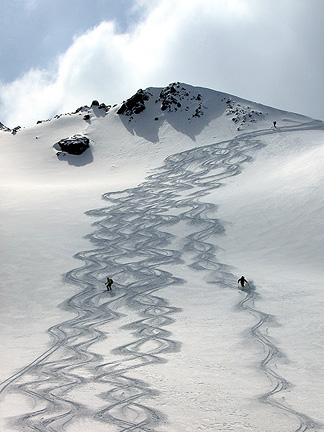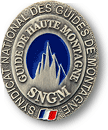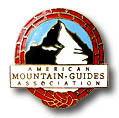 |
|
| Silvretta Ski Touring |
|
6 days skiing Maximum
Group Size See also: |
The Silvretta Group is located along the Swiss-Austrian border just south of the well-known ski resort of Saint Anton. The entire massif is covered with large generally gentle glaciers and big peaks, with many fine ski summits. This is one of our favorite tours. Even though the peaks are not especially high by Alps standards, with most of the higher summits between 3200 and 3300 meters (10,000 to 11,000 feet) in elevation, the mountains area remarkably craggy. And the passes which we cross on each day seem like magical gateways to the next valley, weaving a clever and occasionally surprising route through the convoluted terrain. And the huts – more like alpine hotels – are first rate. This tour offers so many options for various ski ascents (and descents) that they are difficult to describe. All these options give us the opportunity to adjust itinerary to accommodate varying levels of energy and ambition. This is a good "first tour" in the Alps and, if your plans eventually include the Chamonix-Zermatt Haute Route, this is a great training choice. There are also options for the more ambitious among us, with many, many potential summits as we ski from hut to hut. Many of the huts in the Silvretta are run by the German Alpine Club and are known for their spaciousness and comfort. Many have showers, and seem more like alpine hotels than mountain refuges. We base out of the lovely small town of Galtür, not far off the main highway between Innsbruck and Saint Anton. From Zurich, Munich or Innsbruck there is good train service to the town of Landeck, just east of Saint Anton. From here one can take the bus up-valley to Ischgl, then Galtür. Or a taxi can be used from Landeck to Galtür. Generally, the tour follows and east to west arc, crisscrossing the Austrian-Swiss border as we tour from hut to hut. From Galtür on day 1 we catch a bus to the busy ski resort of Ischgl. Riding the lifts we quickly reach the crest of the range. The route travels to the west, crossing high passes on every day, and dropping slightly each night to the next hut. We have added an extra day based out of the Jamtal hut, known for its many fine day-tour options. With Ischgl, Saint Anton and other Innsbruck area ski resorts nearby, consider spending a few days before this tour enjoying the best of Austrian downhill skiing. Or join us for the Albula Traverse, St. Moritz to Davos, which usually precedes this tour on our schedule.
|
|||||||||||||||||||
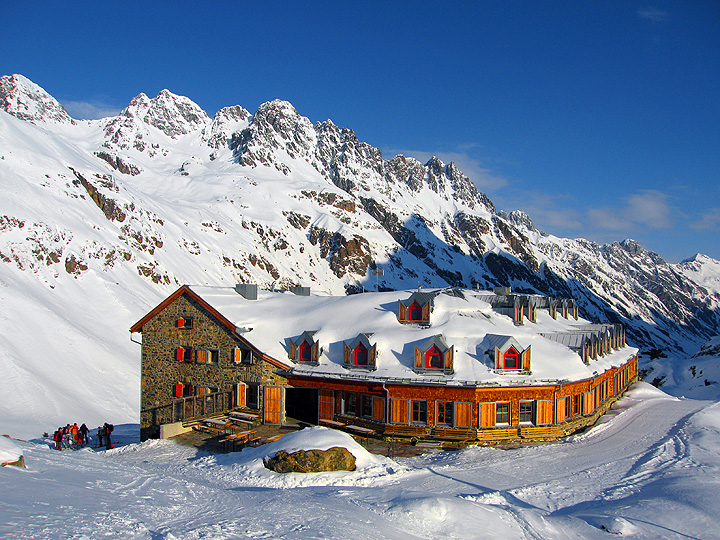 |
|
| The very nice Jamtal hut. We spend two nights here. | |
| Silvretta Ski Touring Itinerary | |
| Day 0 |
Arrive in Galtür, Austria. Rendezvous is at 6 pm in our hotel. Galtür can be reached by train and bus connections from Innsbruck, Munich or Zurich. There is good train service as far as Landeck, then less frequent bus service to Galtür. Alternatively, a taxi can manage the 25-mile section from Landeck to Galtür. |
| Day 1 |
We begin by taking the ski bus down-valley six miles to Ischgl ski area. To begin we ride lifts to the top of the 2864 meter (9394 feet) high Paulinerkopf. From here we can enjoy quite a bit of downhill skiing as we descend the pistes to about 2300 meters. From here a new cable car takes us to the summit of Piz Val Gronda, and the border with Switzerland, at 2812 meters. From here, we ski off piste to the southwest, eventually descending west to the Heidelberger hut at 2264 meters (7426 feet). In poor weather, we have two options: We can take a short lift to Pardatschalpe, at 1660 meters, then ski directly up the easy valley to the hut. Or, we can catch the Heidelberger hut "snow taxi" from Ischgl for a ride directly to the hut. We often arrive early enough to enjoy a good lunch before taking in another short tour, perhaps to the summit of the Ils Chalchogns. |
| Day 2 | On day two we ski to the Jamtal hut. From the Heidelberger hut we ski up a small glacier to a pass near the Breite Krone, the Kronenjoch. An optional ascent of the Breite Krone is a possibility here before our descent to the Jamtal hut, located at 2165 meters (7100 feet). This day involves about 2600 feet of elevation gain, and a bit over 3000 feet of descent. |
| Day 3 | Using the Jamtal hut as a base we can make any number of ski ascents, returning to the hut for a second evening. A couple recommended choices are the Gemsspitz, 3107 meters (10,191 feet), or the Hinter Jamspitz, 3156 meters (10,352 feet). |
| Day 4 |
Jamtal hut to Wiesbadener hut. This is a fairly big day, with an optional ascent of the 3197 meter (10,486 feet) Dreiländerspitze. The climb involves some steep terrain and a ski depot is made below the highest point. The final exposed climb to the airy summit is made on foot with boot crampons. This peak can only be done at low ratios with experienced climbers. Elevation gain for this day is about 1050 meters (3400 feet). |
| Day 5 | We have two nights at the Wiesbadener hut. Again, a number of possibilities present themselves. Perhaps the most demanding is an ascent of Piz Buin. This is a moderately technical climb with some belayed climbing on rock. There are other good objectives as well, such as a tour up to the Fuorcla dal Cunfin or the Tirolerscharte, just above the hut. |
| Day 6 | Our last day, after a gentle climb of about
300 meters, the rest is almost all downhill, though we cover
quite a few kilometers of distance. The preferred route out is
over the Bieltaljoch and down the remote, north-facing Bieltal.
Normally we will be able to ski all the way to Wirl, about 2
kilometers above Galtür. The ski bus will take us this last
short ride to town and our hotel.
We spend the night again in Galtür, and depart in the morning of the next day. |
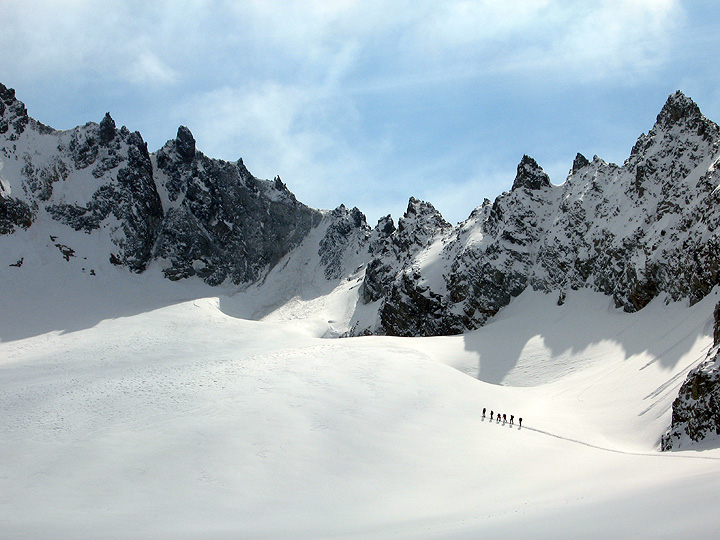 |
|
| Skiers on the upper Ochsentaler Glacier. | |
| Skills Required |
|
This tour requires a high level of fitness and very good skiing abilities. On a number of days the total elevation gained is over 3000 feet. Being in good shape will ensure you have enough energy to manage (and have great fun as well!) on the long descents which follow. The reason that skiing skills must be at an advanced to expert level has more to do with the conservation and expenditure of energy over a long day than the absolute technical difficulty of the skiing. There are a few steep sections, but for the most part the slopes are not overly steep. The challenge comes in managing poor snow conditions (heavy wet snow, crud or breakable crust) and not losing too much energy or risking injury in the process. Great skiers look like they are hardly working, and this is in fact the case. If your skiing is not up to par you will spend far, far more energy than a better skier. Ski skills required;
Skiers who regularly enjoy black or double black runs in most western American ski areas should do fine. If you like to get off the piste and into the crud, ski the trees, and in general look for the steeper shots, you'll probably have a great time on this tour. If you tend to stick to the groomed slopes and find the wild untracked a bit intimidating you should think twice about this option. We will likely encounter all different kinds of snow, from the best to the worst, and you need to have sound, energy-efficient strategies to cope with them. A good gauge of your ability can be found in mogul skiing. If you are good in the bumps and seek them out, then you most likely have developed the rhythm and balance needed for steep or difficult snow. You must be able to ski moderate bumps in good conditions, skiing rhythmically and fluidly, following a line near the fall line with good speed control. If you have any doubt about your ability to manage the skiing on this tour, please contact us to see if we can answer your questions. Previous ski touring or mountaineering skills are useful, but not required. If you are a good skier, you will not have difficulty picking up these new skills, as you will already be comfortable on steep slopes. |
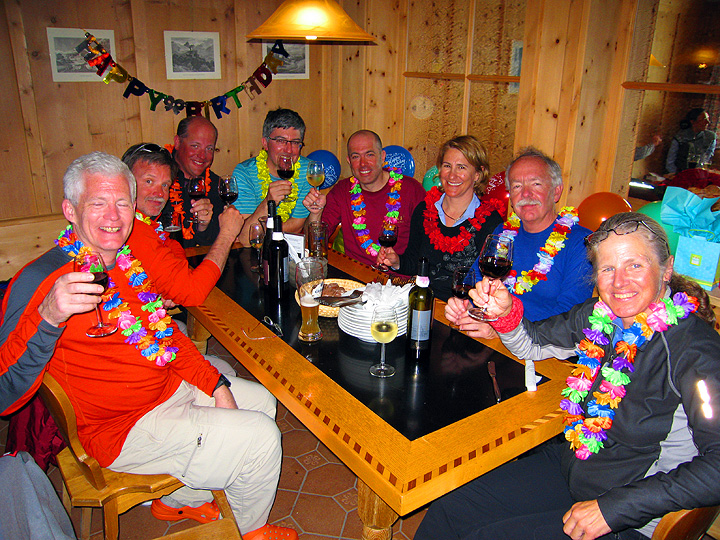 |
|
| Celebrating a milestone birthday in the Jamtal hut. | |
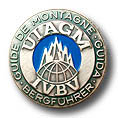 |
Kathy Cosley &
Mark Houston AMGA Certified • SNGM
members All images, layout and text ©2004 Cosley & Houston Alpine Guides, All Rights Reserved |
|
